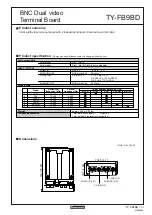
Hans Turck GmbH & Co. KG • Tel. +49 208/4952-0 • Fax +49 208/4952-264
12
Instructions for use – Ultrasonic sensors series “High-End“
Sensor pinout (slaves):
Pin
Pin assignment
Wiring diagram
Pin 1
+24 VDC
Pin 2
Output 2 (analog output or switching output)
Pin 3
GND
Pin 4
Output 1 (switching output)
Pin 5
Release input
4.4.6
IO-Link operation – Opposed mode
The Opposed mode is used to enlarge the range of an ultrasonic application. For this, sensors of the same type are
used in pairs and operate as emitter and receiver.
nOTE
Devices of the same type are required
In order to ensure proper functioning of the Opposed mode, all connected sensors must have the same perfor-
mance and range. Only operate sensors with the same type code in the Opposed mode. The type code is applied
on each device, please refer to p. 6 for the declaration of the type code.
Sensor pinout (emitter):
Pin
Pin assignment
Wiring diagram
Pin 1
+24 VDC
Pin 2
n.a.
Pin 3
GND
Pin 4
Trigger output, connected to Pin 5 of the receiver
Pin 5
n. c.
Sensor pinout (receiver):
Pin
Pin assignment
Wiring diagram
Pin 1
+24 VDC
Pin 2
n.a.
Pin 3
GND
Pin 4
Output signal for object detection, signal in accordance with the
following table
Pin 5
Trigger input, connected to Pin 4 of the emitter
4.5
Output behavior
The ultrasonic sensors of the “High-End” series are provided with two switching outputs that can be set indepen-
dently of each other. Output 1 can be used exclusively as a switching output. Output 2 is factory set as an analog
output and can be used either as a 4…20 mA / 0…20 mA current output, a 0…10 V / 0…5 V / 1…6 V voltage out-
put or as a switching output.
The start and end point of the switching range can be set for the switching outputs. The switching range must be
within the sensing range. The device can be used as a diffuse mode or retro-reflective sensor.
When used in diffuse mode, either a single switch point or a double switch point is defined. The double switch
point is used for window or hysteresis functions.
When using the hysteresis function, a switching range is taught that is defined by two switch points. The switching
outputs have the following behavior as outputs: If an object is moved away from the sensor, switching output 1 is
switched on for as long as the object is located between the beginning of the sensing range and the 2nd switch















































